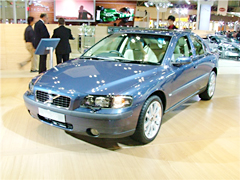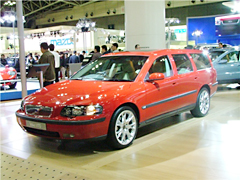 |
 |
 |
 |
 |
 |
|
Like Volvo's higher-end S60 and S80, all-new Volvo S40 continues Volvo design traditions, including the dynamic V-shaped bonnet, signature "Volvo bridge" side window line, wide shoulder lines, dark gray metallic vertically positioned radiator grill, flowing silhouette lines and sharp drop-off tail. The design helps to convey a vibrant sense of speed, eliciting the image of a comet. The expanded tread and wheel base not only create a dynamic, road-hugging performance and comfortable, stable ride, but also have proportions reminiscent of a sports car. The longer wheel base has allowed a wider rear door, enhancing passenger convenience. All-new Volvo S40 is slightly shorter than its predecessor, but is both wider and taller, creating more abundant cabin space. The cabin is surprisingly open in a way one wouldn't guess from the model's exterior appearance. Volvo designers have achieved this using the company's traditional cabin-forward design, the long wheel base, and a transverse engine installation.
|
|
 |
 |
 |
|
The interior of the new Volvo S40 boasts a completely new design. The unique free-standing center console, designed following ergonomic principles, is completely independent of the dashboard, contributing to the interior spaciousness, even within the S40's compact body. The console functions as an important control panel for the driver.
|
|
 |
 |
|
Volvo developed all-new Volvo S40 with the aim of assuring a level of safety comparable to that of its higher-end models. All-new Volvo S40 includes a number of proprietary technologies that assure the degree of safety drivers have come to expect in a Volvo car. These include a rigid body, a redesigned front-end with patented multiple crumple zones, and an Intelligent Driver Information System (IDIS) which copes with the driving condition by computer.
|
|
 |
 |
|
The S40's new 2.4 liter or 2.5 liter five-cylinder in-line engine generates powerful torque even at low speeds for rapid acceleration. The engine's low vibration, smooth performance allows drivers to enjoy comfortable and sporty driving.
Although the S40 is designed with a compact body, it delivers high-end automotive quality and functions. Its exciting design and outstanding driving characteristics make it a strong competitor in its class. |
|
 |
 |
 |
 |
 |
2. Versatility Concept Car (VCC) |
 |
 |
 |
 |
 |
 |
|
The Versatility Concept Car (VCC), now premiering in Japan, represents a view of the future of high-class estate from Volvo, long the estate standard-setter in the auto industry. Inspired by traditional Volvo designs, the VCC's exterior is immediately recognizable as a Volvo. Distinctive elements include slim vertical headlights comprising an arrangement of three light units that each orient in the direction of travel, a roof panel that incorporates solar panels, and a sideways opening rear door, which allows for the elimination of the B pillar, providing greater openness. The VCC also inherits a tradition of luxurious Scandinavian universal simplicity; the central console includes climate control and security functions only. The luggage space also utilizes high quality materials in every detail to create a high-class functional space that includes a power extendible load floor to assist loading and unloading of cargo. Appropriate for "a revolutionary vehicle, a vision of 10 years in the future," the VCC's innovative engine and transmission were designed for high fuel efficiency and include new turbo technology and direct starting and stopping, which reduces fuel consumption. Forming the in-car communications system, various wireless information terminals are located for convenient access by driver and passengers. The VCC also pushes the global leading edge of environmental technology with its roof-mounted solar panels that power the air conditioner even when the engine is stopped, and new Volvo technology called the Volvo Ambient Air Cleaner (VAAC), which absorbs two groups of harmful atmospheric pollutants emitted by other vehicles, hydrocarbons (HC) and nitrogen oxides (NOx). This is the first model to include the VAAC system. The VCC is the ultimate concept car hinting at the kind of elegance and quality that Volvo's V range promises for the future.
|
|
 |
 |
 |
|
Volvo S60 became popular as a new breed of mid-sized sports saloon following its release in 2001 for its unique shape called a four-door sports coupe, dynamic handling thanks to the wide tread & short length body proportion and typical Volvo practicality. The release of Volvo S60 has, in a positive sense, cleared away the long-standing image that "Volvo equals estate car." The 2004-model has five grades: the S60, S60 2.4, S60 2.5T, S60 AWD, and S60 T-5 Sport. The main differences from the 2003-model are; the engine capacity increase of the FF drive light-pressure turbo (2.5T) with an improvement by 9hp in horsepower and 12% increase in torque with the change to a cleaner excellent low-emissions certified vehicle, newly designed door mirrors, Bi-Xenon headlights option (T-5/standard), further color-coordinated interior and chrome-ring instrument panel meters.
|
 |
 |
|
 |
 |
 |
 |
|
Volvo V70 has earned a global reputation as being the pinnacle of the estate car format, incorporating know-how acquired over the fifty years since the debut of Volvo's first estate, "the Duett." The 2004-model has five grades: the V70, V70 2.4, V70 2.5T, V70 AWD, and V70 T-5 Sport. The main differences from the 2003-model are; the engine capacity increase in FF drive light-pressure turbo (2.5T) with an improvement by 9hp in horsepower and 12% increase in torque with the change to a cleaner excellent low-emissions certified vehicle, newly designed door mirrors, Bi-Xenon headlights option (T-5/standard), further color-coordinated interior and chrome-ring instrument panel meters, "Sports Plus Package" newly available for T-5 Sport.
|
 |
 |
|
 |
 |
|
 |